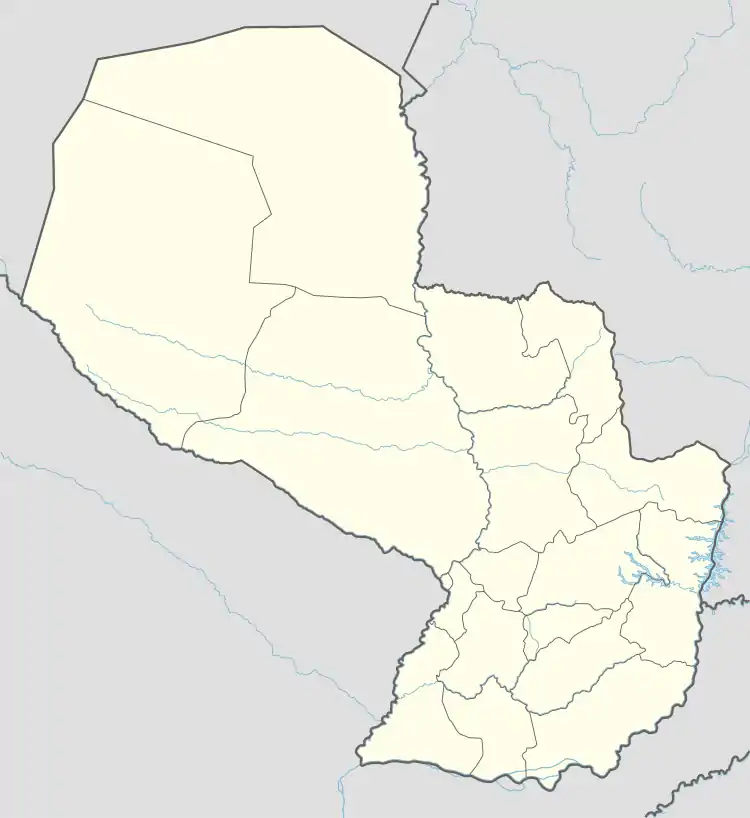Santiago | |
|---|---|
City | |
| Santiago | |
 Iglesia de Santiago | |
 Santiago | |
| Coordinates: 27°9′0″S 56°47′0″W / 27.15000°S 56.78333°W | |
| Country | Paraguay |
| Department | Misiones |
| Re-founded | 1669 |
| Government | |
| • Intendente Municipal | Américo Romero Sanabria (Liberal Party) |
| Area | |
| • Total | 740 km2 (290 sq mi) |
| Elevation | 69 m (226 ft) |
| Population (2008) | |
| • Total | 7,702 |
| • Density | 9/km2 (20/sq mi) |
| Time zone | UTC−04:00 |
| Code Postal | 4860 |
| Area code | (595) (782) |
Santiago is a city in Paraguay, located in the Misiones Department in the south of the country.
Toponym
Originally named San Ignacio de Caaguazú, it was re-founded in the Misiones department, Paraguay, in 1669 with the name of Santiago Apostol.
History

Santiago stands as an ancient city with roots as a Jesuit mission settlement, proudly retaining the timeless traits of its colonial past. These include its expansive main square, the historically significant "house of the Indians," and a meticulously curated museum safeguarding colonial-era artworks.
In the colonial epoch, Santiago held a position of significance owing to its population, which flourished to approximately 3,000 inhabitants.
Throughout festive periods, the city orchestrated the grand spectacle of the Opera of Santiago, underscoring its cultural vibrancy and artistic fervor.
Geography
Santiago is located 278 kilometers from Asunción, the capital Paraguay. It is located on a hill between the cities of Ayolas and San Patricio.
The geography of Santiago is characterized by rolling hills, forests, and grasslands. The city is surrounded by dense forests and agricultural land, with the Paraguayan Chaco to the west and the Paraná Plateau to the east.
The Tebicuary River is an important part of the geography of Santiago, providing a source of water for agriculture and transportation. The river is also home to a variety of fish species, which support the local fishing industry.
Climate
In summer, the temperature reaches 39°C, and in winter can drop to 0°C. The annual average is 21°C.[1]
The climate of Santiago is subtropical, with warm temperatures year-round and a distinct rainy season from October to April. The region receives ample rainfall, which supports the growth of lush vegetation and crops.
Population
Santiago has a population of 7,702 inhabitants, 4,017 men and 3,685 women, according to the General Direction of Polls, Statistics and Census.[2]
Economy
The people of Santiago mostly raise cattle. Other local agriculture includes corn, sugar cane, cotton and soy.
Municipality
The former governor is Ignacio Larre (Liberal Party).
Tourism

Santiago has a sacred art museum, the "Museo Jesuítico de Santiago" (Jesuit Museum of Santiago). The museum displays paintings and sculptures, including a collection of 3 sculptures depicting the Passion and Death of Jesus Christ and La Piedad.
The church preserves many images carved in wood by the natives. The "House of the Indians" museum exhibits images of saints. The church has a unique altarpiece in the Missions, many of the pictures in the church center around biblical themes.
The Benedictine monastery "Tupasy María" is a place of meditation, it was founded in 1984.
In January the "Fiesta de la Tradicion Misionera" (Missioner Traditional Festivity) brings horse breakers from Paraguay, Argentina, Brazil and Uruguay to show their abilities in racing and breaking in horses. Traditional Paraguayan food is sold at the festival, including "Batiburrillo", sopa and Chipa guasu with barbecues and the traditional Mandioca. The festival is usually held on January 20, 21 and 22. Michel Telo performed at the festival in the 2014. It is organized by the "Club de Leones" of Santiago Misiones, and claims to be the biggest rural traditional festivity in Paraguay.
The State "Tacuaty" is place for the Festival of Breaking-in and Folklore, located on the road to Ayolas.
References
- ↑ "Santiago, Paraguay weather in June: average temperature & climate". Wanderlog. Retrieved 2022-05-25.
- ↑ "Population of Santiago Paraguay".
- Geografía Ilustrada del Paraguay, Distribuidora Arami SRL; 2007. ISBN 99925-68-04-6
- Geografía del Paraguay, Primera Edición 1999, Editorial Hispana Paraguay SR